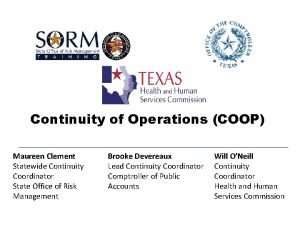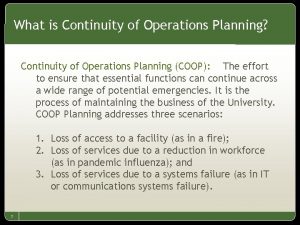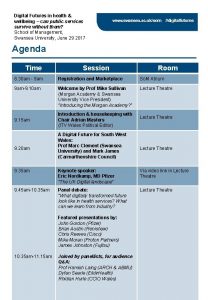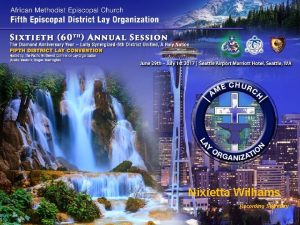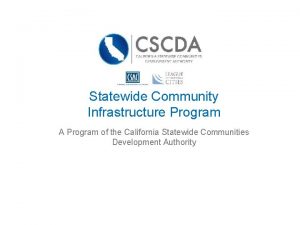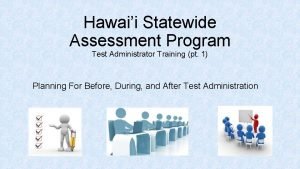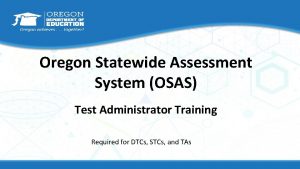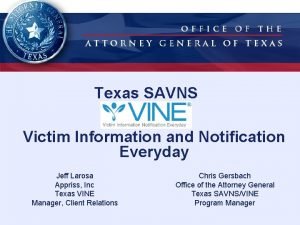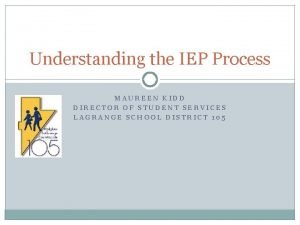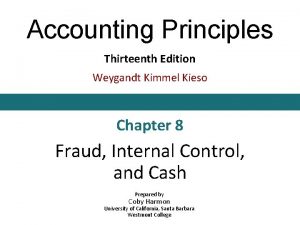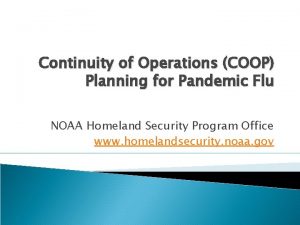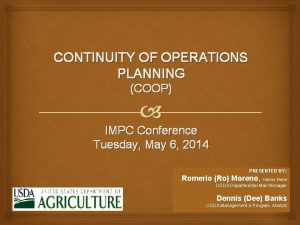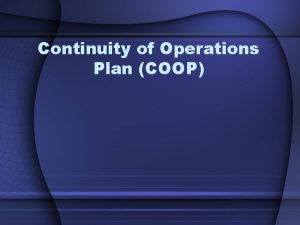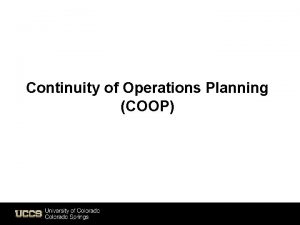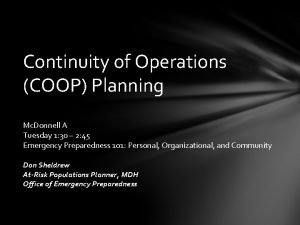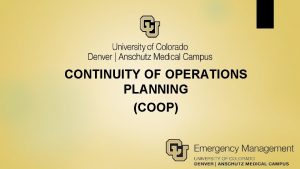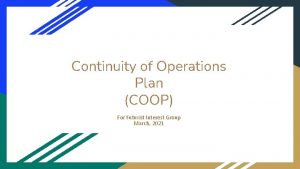Continuity of Operations COOP Maureen Clement Statewide Continuity











































- Slides: 43

Continuity of Operations (COOP) Maureen Clement Statewide Continuity Coordinator State Office of Risk Management Brooke Devereaux Lead Continuity Coordinator Comptroller of Public Accounts Will O’Neill Continuity Coordinator Health and Human Services Commission

Importance of COOP The State of Texas must be prepared to ensure the continuing performance of essential functions under all conditions, including localized acts of nature, accidents, and technological or attack-related emergencies. 2

Policy Letter Background “…Texas must be prepared to ensure the continuing performance of critical government functions under all conditions…” State Agency Continuity Plans have been required by law since 2003 Texas Homeland Security identified lack of and inadequacy of Continuity of Operations Plans by state agencies as a major area of concern in 2013 3

Policy Letter Background The COOP Policy Letter, sent to all Commissioners and Executive Directors of state agencies on October 2013, was designed to address continuity and preparedness shortcomings – Signed by the Homeland Security Advisor to the Governor and Director of Department of Public Safety (DPS) – Signed by the Director, Department of Information Resources (DIR) – Signed by the Director, State Office of Risk Management (SORM) 4

Policy Letter • Applies to all state agencies • Provides additional guidance on continuity planning to state agencies, consistent with existing legislation and rules • Continuity Planning Crosswalk – established as the single recommended standard for minimum content in the Texas State Agency Plans (p. 2, para 1) • Texas Essential Functions established as primary focus of state government during a crisis (p. 1, para 3) 5

House Bill 1832 Signed by Governor Abbott on June 19, 2015 Texas Labor Code 412. 054 • Continuity of Operations is the standard in the State of Texas • Information contained in COOP Plans developed under the requirements of TLC, Section 412. 054 are confidential and excepted from public disclosure. 6

Contingency Plans Types of Plans: • Continuity of Operations (COOP) Plan • Business Continuity Plan (BCP) • Disaster Recovery Plan (DRP) • Information System Contingency Plan (ISCP) • Occupant Emergency Plan 7

Continuity of Operations Plan (COOP) • COOP Plan - Is an all hazards plan that focuses on restoring an organization’s mission essential functions (MEF) at an alternate site and performing those functions for up to 30 days before returning to normal operations. Government agencies use COOP Plans. 8

Business Continuity Plans (BCP) • Business Continuity Plans (BCPs) are based on the Business Impact Analysis (BIA) and is often scenario driven. Non-government organizations typically use BCPs. 9

Disaster Recovery Plans (DRP) • Disaster Recovery Plan (DRP) is an information system-focused plan designed to restore operability of the target system, application, or computer facility infrastructure at an alternate site after an emergency. The DRP only addresses information system disruptions that require relocation. 10

Information System Contingency Plan (ISCP) • Information System Contingency Plan (ISCP) developed for recovery of the system regardless of site or location. An ISCP can be activated at the system’s current location or at an alternate site. 11

Occupant Emergency Plans(OEP) • Occupant Emergency Plans (OEPs) outline first-response procedures for occupants of a facility in the event of a threat or incident to the health an safety of personnel, the environment, or property. The OEP may be appended to the COOP plan, but is executed separately and as a first response to the incident. 12

Why Develop COOP Plans? COOP Planning provides answers – in advanceto tough questions that you would not want to answer “on the fly” as a disaster is spreading around you. 13

Four Phases of COOP 14

Elements of a Viable Continuity Capability Essential Functions Orders of Succession Delegations of Authority Continuity Facilities Continuity Communications § Essential Records Management § § § Human Resources § Test, Training, and Exercise (TT&E) Program § Devolution of Control and Direction § Reconstitution 15

COOP Plans and IT Disaster Recovery Plans In a Continuity of Operations Plan, Information Technology is considered a resource, not a Mission Essential Function (unless IT is the mission of the agency) 16

Essential Records Management is one of the main elements of COOP and a separate Annex should be dedicated to the identification, protection and ready availability of an agency’s Essential Records. 17

Essential Records Management The following table shows examples of how Essential Records, files, and databases are documented in a COOP Plan Essential Record, File, or Database Support to MEF Form of Record Mapping Database Function #1 Electronic Contractors List Function #1 & #3 Hardcopy Regional Dams List Function #2 Hardcopy Pollution Incident Database Function #3 & #4 Electronic Sewage System Records Function #3, #4 & #5 Electronic Prepositioned Hand Carried X Multiple Storage Locations (Y/N) Maintenance Frequency Y Monthly X N Quarterly X N Annually X N Monthly X Y Quarterly 18

COOPs…Not Oops Texas Comptroller of Public Accounts Continuity of Operations (COOP) Brooke Devereaux Continuity Coordinator Comptroller of Public Accounts

Comptroller Background • State’s Chief Financial Officer, Chief Revenue Estimator, and Purchasing Manager • Manages over $57 billion in assets • 3, 000 Employees • 52 Field Offices; 4 out-of-state 20

Continuity Planning Cycle Business Impact Analysis Continuity Plan Improvements Test, Training and Exercises 21

Meeting State Requirements 2014 • Contracted with Gartner Consulting • BIA Pilot Project • Drafted Agency Plan 2015 • Completed BIA Project with all divisions • Division Plans • Updated Agency Plan • Test, Training & Exercise Program 22

Business Impact Analysis Process Conduct BIA Kickoff Collect BIA Survey Response Conduct BIA Validation Workshop Draft BIA Division Report Consolidate Division BIAs into Agency BIA Receive Executive Sign-off on Agency BIA IT Updates Disaster Recovery Plan with BIA Results Completed for each division. 23

CPA Mission Essential Functions • Receive Funds • Disburse Funds • Monitor Spending 24

Continuity Plans CPA maintains two levels of plans: • Agency Plan • Division Plans 25

Agency Plan • Alert & Notification Process • Communication Process • Roles & Responsibilities • Facilities & Space Allocation • Reconstitution • Test, Training & Exercise 26

Division Plans • Business Procedures • Roles & Responsibilities – Leadership – Emergency Relocation Group – Teleworkers – Non-Emergency Relocation Group – Delegation of Authority • Call Tree Contact Information 27

Test, Training & Exercises • Sequential & Progressive – Awareness Training – Call Tree Test – Table Top Exercise – Full Scale • Corrective Action Plan 28

The Great Flood After Action Report Former Dept. of Assistive & Rehabilitative Services Texas Health and Human Services Will O’Neill Business Continuity Coordinator October 11, 2016

The DARS GREAT FLOOD Occurred overnight on September 30, 2013 Water line on 3 rd floor burst Extensive flooding discovered on Tuesday morning, October 1, 2013 Originally thought to be a 2 or 3 day event Scheduled to return to building November 2014 174 staff evacuated 119 out of 174 staff responded to the survey 19 supervisors responded


The Culprit

General Questions




Telework and Vital Records




Conclusions 1 - Unsatisfactory 10 -Excellent

Final Thoughts The DARS evacuation went very well DARS continued seamless operations Seventy percent laptop distribution was the key DARS Staff happy with teleworking DARS Staff satisfied with access to vital records DARS Staff not happy with temporary workspace DARS Supervisor’s calling trees and overall communication need improvement A calling tree/communications exercise to be scheduled for this summer

Continuity of Operations (COOP) Maureen Clement Statewide Continuity Coordinator State Office of Risk Management 512 -936 -1477 Maureen. Clement@sorm. texas. gov Brooke Devereaux Lead Continuity Coordinator Comptroller of Public Accounts 512 -475 -5635 Brooke. Devereaux@cpa. texas. gov Will O’Neill Continuity Coordinator Health and Human Services Commission 512 -487 -3344 William. ONeill@hhsc. state. tx. us
 Maureen clement
Maureen clement Continuity of operations plan definition
Continuity of operations plan definition Modernist painting greenberg
Modernist painting greenberg Jacot ntk
Jacot ntk Marc clement swansea university
Marc clement swansea university Transfert et contre transfert
Transfert et contre transfert Region segmentation
Region segmentation Mieke clement
Mieke clement Clement of alexandria paedagogus
Clement of alexandria paedagogus Orthses
Orthses Bishop clement fugh
Bishop clement fugh Odile clement
Odile clement Clement farabet
Clement farabet Absolute continuity implies uniform continuity
Absolute continuity implies uniform continuity Statewide construction and development
Statewide construction and development Arizona statewide independent living council
Arizona statewide independent living council Statewide community infrastructure program
Statewide community infrastructure program Statewide benefits
Statewide benefits Statewide vendor number
Statewide vendor number Sba testing hawaii
Sba testing hawaii Michigan state industries
Michigan state industries Osasportal.org
Osasportal.org Statewide health insurance benefits advisors
Statewide health insurance benefits advisors Savns
Savns Ct savin
Ct savin New york statewide senior action council
New york statewide senior action council Maureen hanlon
Maureen hanlon Dublin high school maureen byrne
Dublin high school maureen byrne 9 box talent review
9 box talent review Maureen binder
Maureen binder Maureen frugali
Maureen frugali Maureen koval
Maureen koval Maureen blackwell
Maureen blackwell Dr maureen padden
Dr maureen padden Maureen wilcox lottery
Maureen wilcox lottery Profiles of the gifted and talented
Profiles of the gifted and talented Www verifyos com
Www verifyos com Maureen kidd
Maureen kidd Andriy koval
Andriy koval Maureen frugali
Maureen frugali Maureen petterson
Maureen petterson Maureen cropper
Maureen cropper Maureen donaghy
Maureen donaghy [email protected]
[email protected]
